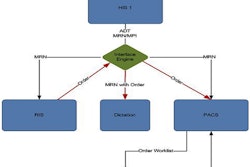
Over the past year, the concept of cloud-based PACS has generated much excitement, as well as hype, uncertainty, and disillusionment. As a managed services model, however, cloud PACS will not achieve widespread adoption until technological and, most importantly, economic issues are addressed.
In assessing the market for PACS in its latest report, "World Market for PACS, RIS, and CVIS -- 2011," InMedica analyzed different PACS business models and found that cloud systems fall primarily under the realm of "managed services."
Managed services (MS) refers to a model in which the vendor owns and manages the IT infrastructure, providing service level management, application, and system administration. The vendor is also fully responsible for maintaining this infrastructure, including the data center/storage, which may be housed locally or remotely.
Benefits of managed services include reducing the need for heavy capital investment in PACS, such as costly in-house IT support staff and IT infrastructure investment. This model also provides regular access to the latest software upgrades and allows flexible storage capacity to suit end users' needs.
Defining cloud PACS
There are different forms of managed services depending on the location of the two components of PACS: software and storage (see table 1). In any managed services model, the underlying factor is the pay-per-service and third-party hosting or ownership of PACS.
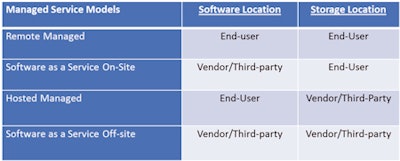 |
| Table 1: Definitions of managed services models. The terms "onsite" and "offsite" refer to the location of storage relative to the end user. "Remote" and "hosted" refer to the location of storage relative to the vendor/third party. Source: InMedica. |
Cloud storage refers to an approach where the storage remains with the vendor or third party, such as the hosted managed and software-as-a-service (SaaS) offsite models. This is well understood and many companies offer cloud storage services for healthcare. There is, however, a difference between sending local images from a local PACS server to a cloud-based storage site, and having the PACS server already cloud-based.
PACS incorporates storage and software components. Arguably, software is the main component of PACS, as this is what allows radiologists to view and interpret patient images. Hence, at which point does one begin to classify PACS as "cloud-based"?
- Is it the moment the software is at a third-party server, as in SaaS onsite?
- Is it when the storage is remotely available on the third-party server, as in hosted managed services?
- Or is it only when both software and storage components are hosted by the third party, as in SaaS offsite?
Companies offering cloud PACS tend to fall into one of these categories, depending on whether their offering is cloud-based from a software or storage point of view. True cloud PACS, by InMedica's definition, occurs when both software and storage components are hosted by a third party.
At both RSNA 2010 and 2011, there was no shortage of "cloud" marketing. The difference between the two shows, however, was that more PACS vendors had products that had progressed from alpha to beta testing or beta to formal launch. It's not the easiest task, however, to elucidate what the services behind these models are in terms of data center housing, software/application hosting, and management. As such, it's uncertain whether they are really cloud-based or not. Even client virtualization systems were referred to as cloud PACS.
As the PACSman once said, RSNA seems to stand for "Real System Not (yet) Available." In the case of cloud PACS, even if these systems are now available, it was certainly "Real Systems Not (yet) Adopted." We estimate that, combined, less than 10% of these vendors' sites were actually using these new offerings, whether we count them as cloud-based or not. There's a long way to go.
Technology adoption
More important than definitions, of course, is the adoption of this technology. The technology and the business model have to work for both suppliers and end users. On the technology side, one might be more confident that vendors will resolve the technical hurdles such as the quality of the data when transferred between locations and servers, as well as the quality of the interfacing.
On the business model side, however, confidence is much lower and many questions remain:
- Will hospitals be completely comfortable with third-party hosting of patient data, regardless of HIPAA compliance?
- Will patients indeed be comfortable with this knowledge?
- What about the cost-savings? Is the total cost of ownership over the product lifecycle significantly different from traditional PACS models?
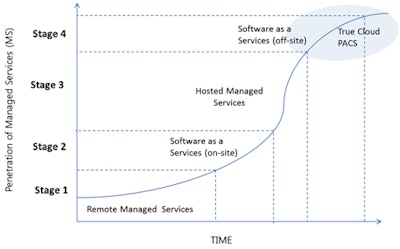 |
| Figure 1: Toward the cloud. Development of cloud PACS linked to the adoption of managed services business models. Source: InMedica. |
Vendors need to do a lot of work to improve cloud PACS technology. However, the critical issue is the business model. In the diffusion of cloud technology in imaging, it is our assertion that the business model, not the technology, will remain the bottleneck of market adoption.
The development of cloud PACS, regardless of definition, is inextricably linked to the development of managed services business models as a whole. Until remote managed services models (as defined in table 1) are widely understood and accepted, the other managed services models, which move us closer to the cloud, will not take off. The remote managed services model is essentially the simplest form in the business of outsourcing PACS infrastructure to third parties and paying on a subscription basis.
However, at least in this case, the software and data are still kept at the hospital's site. Only when the return on investment of subscription-based, vendor-owned PACS is proved, and hospitals still have some oversight of their data, will the notion of moving that software or data to an offsite location gain credibility (see table 2).
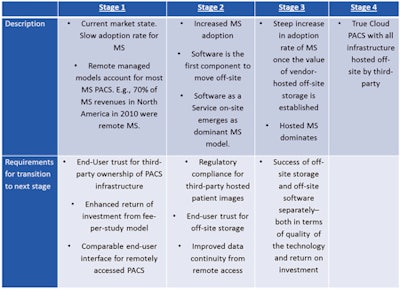 |
| Table 2: Stages in the development of managed services. Source: InMedica. |
The first component to move offsite is the software, the success of which depends on the ability of the system to retain end-user functionality. This must be retained while enabling remote access from dedicated workstations or other platforms, whether the end user is in the hospital or not. Moving storage offsite is much more sensitive. Hospitals that have already adopted a remote managed model and have seen benefits from outsourced data management to the vendor will be much more likely to accept the transfer of data to that vendor's server at an offsite location.
Market state
To quantify this trend in the North American market, traditional PACS accounted for the largest proportion of PACS revenues in 2010. However, the availability of remote managed services is growing and accounted for 13% of North American PACS revenues in 2010. Fewer vendors successfully offer other PACS models and this is reflected in the low penetration of SaaS and hosted managed models.
If we define the ultimate cloud PACS as having both storage and software hosted by a third party, as in SaaS offsite, then this accounted for less than 1% of total North American PACS revenues.
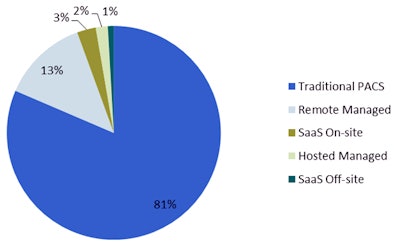 |
| Figure 2: Relative proportions of North American radiology PACS revenues -- 2010. Source: InMedica. |
The development and diffusion of cloud technology in imaging is still relatively immature. However, widespread adoption of cloud technology will continue to be hindered until the business of vendor-hosting in terms of security, regulatory compliance, end-user trust, and return on investment is met.
Theo Ahadome is lead market analyst for healthcare IT at InMedica (in-medica.com), the medical research division of IMS Research. The information in this article is obtained from InMedica's research on healthcare IT markets, including PACS, RIS, CVIS, enterprise management, cloud storage, and vendor-neutral archives.
The comments and observations expressed herein do not necessarily reflect the opinions of AuntMinnie.com, nor should they be construed as an endorsement or admonishment of any particular vendor, analyst, industry consultant, or consulting group.






